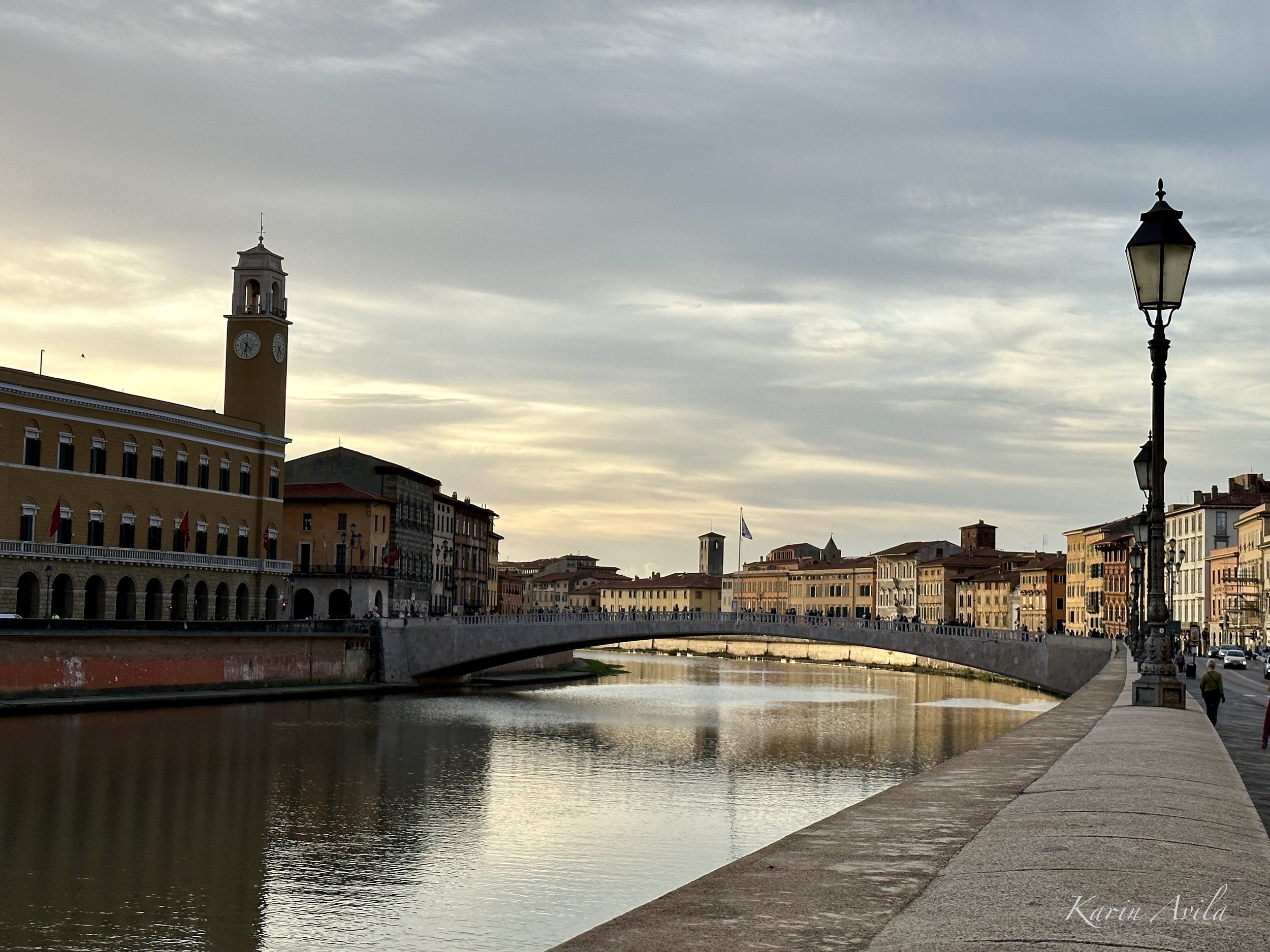Give Pisa Chance
Pisa, Italy
On my way to Siena, I decided to stay for one night to check out the famous Tuscan city of Pisa. “There’s not much to see.” they said, “It’s not worth staying overnight.” they said, chuckling at the notion. Respectfully, I beg to disagree. There’s more to Pisa than the famous leaning tower. In fact, the marvelous structures surrounding, nay dwarfing, the tower were far more impressive.
When I arrived in Pisa, I wasn’t expecting much, based on the sought-after advice from experienced and well-traveled chums. True, the scenery as I left the train station was nothing short of average at best, but once I emerged from a pedestrian street heading towards the center of Pisa, I met up with the Arno River in perpendicular fashion and the city began to blossom.
Arno River at sunset in central Pisa
It was too early to check-in to my hotel, so I opted to familiarize myself with the city streets, eventually stopping for a bite to eat in the popular Borgo Stretto district where I would sample one of the best pizzas I’ve ever tasted (you can read about local foodie adventures in “Tuscan Delights,” posting soon). Because I was traveling light with only one small backpack, I was able to cover a lot ground. I found the stacked buildings charming, the colorful array of structures scintillating, and the narrow winding streets irresistible.
Residential window in central Pisa
After getting the lay of the land, including where the famous tower stood, I quickly headed back out after eventually checking into my hotel, Casa San Tommaso – the hotel was basic and quaint, tucked conveniently into a side street corner, steps away from the tower and still quiet to avoid feeling as if I was in the middle of a tourist district. The map of the old town was seared into my mind with a few key highlights I wanted to bank during my short stay. Unlike most of my trips, I hadn’t researched Pisa in advance of my visit. Aside from the tower, I wasn’t sure what else it had to offer. During my stay, I discovered Pisa offers a competitive food scene, several historic structures of interest, and a particularly notable resident, Galileo, born in Pisa in 1564.
Despite the prospect of other alluring sights, the leaning tower was must a must-see. And it certainly is an odd structure to behold, especially as it basks in the dazzling glow of its neighboring structures: Cattedrale di Pisa e Battistero di San Giovanni (Pisa Cathedral and Baptistery of Saint John). To say these structures are towering underestimates their visual impact. They made the people strolling around them and lounging on the grass near them appear as small as ants. It felt as if some mythical giant erected these structures; that we were in some fantastical land straight out of Gulliver’s Travels. How could human hands create such robust, delicate ornate work at these heights that can withstand time and the elements?
Battistero di San Giovanni (Baptistery of Saint John) in Piazza dei Miracoli (Plaza of Miracles)
Construction of the baptistery began over 800 years ago in the 12th century, and it took nearly 200 years before it was completed. Historically, the structures were built with an octagonal floor plan. In this case, the one in Pisa was perfectly circular. The baptistery is slightly younger than the neighboring cathedral, construction having started just over 900 years ago.
Cattedrale di Pisa (Pisa Cathedral) with the famous Torre di Pisa (Pisa Tower) to the right in Plaza of Miracles
Gliding in awe over terra firm dominated by towering edifices in Romanesque style, I headed towards the ancient city wall for a walk. The wall is made of limestone called marble of San Giuliano and, not surprisingly, was built as a defense for the city. The Pisa walls are some of the most ancient in Italy, also built in the 12th century. On the western end, there were stone lions marking where the gates to the city used to stand. The wall was a pleasant and unforeseen surprise – three kilometers of uninterrupted walking on a path located on top of the structure with scenic views of the city running along the north.
The Baths of Nero, only remaining Roman ruins in Pisa, with Pisa wall to the right
Roughly one kilometer into the wall-walk, I spotted ruins sitting in the middle of cross streets near my hotel, which I had somehow missed before. I would soon find out these were ancient Roman baths, The Baths of Nero, the only remaining Roman ruins in Pisa. As I continued along the path, I saw students studying in a garden below near a church, and what I presume was a university or other academic facility. There were public parks, residences, and retail buildings all visible from the wall. Eventually it wrapped around the east and down towards the south, where the wall gently delivers pedestrians near the Arno River.
Colorful scene viewed from the ancient wall with what looks like electronic waste
Pisa is well-worth a visit. I would argue that travelers could stay occupied through two nights and perhaps three. There are several good restaurants to try, impressive buildings to admire, and museums to visit, including Cantiere Le Navi Antiche di Pisa that boasts ancient Roman ship remains. During my short trip, I didn’t have the opportunity to visit any museums, and I wasn’t able to see the inside of the baptistery due to construction. Although I left Pisa feeling satisfied, I would happily return and pick up where I left off, diving deeper into local cuisine and exploring more intimately her beckoning streets and structures.





